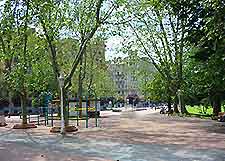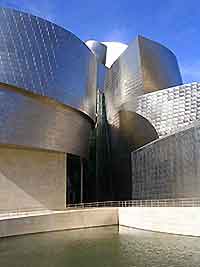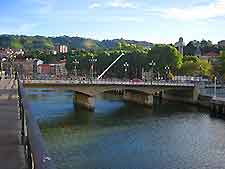Bilbao History Facts and Timeline
(Bilbao, Biscay, Basque Country, Spain)

Located on the banks of the Nervión River, Bilbao is the capital of the Biscay province of the Basque country and has a recorded history dating back to the very beginning of the 14th century.
Since that time it has been an important commercial centre, mainly based around the port and its associated exports. In the 19th century, the industrial revolution led Bilbao to become one of the biggest and most noteworthy manufacturing centres in the whole of Spain.
Ancient Origins
Ancient burial sites which date back more than 6,000 years have been discovered in the region. Meanwhile, other evidence of human inhabitation has been found dating back to around the 3rd century BC. However, the history of Bilbao begins in earnest during the 14th century, when it was the first of several Biscayan municipalities.
The Middle Ages
The city really started to blossom during the 16th century, following the formation of the Consulate of Bilbao. The city's port bloomed under the Consulate's direction, while the city also began to print books in the latter half of the century. In the 1590s, the very first book to be written in the Basque language was actually published here.
The Basilica de Begona was built during this period and remains the most important religious site in the city. Part of this church was destroyed during the First Carlist War, being fully reconstructed in the early part of the 20th century. Another important church from this time is the Gothic-style San Antón Church, which features on the city's shield.
By 1602, Bilbao had become an extremely wealthy city and as such, it was recognised as the capital of Biscay. The country continued to expand during the 17th century, relying on its iron ore production and trade with countries based within northern Europe.

19th-Century Conflict
During the 19th century, the Basque country came under increasing attack from the Carlists, who besieged the city no less than three times in an effort to plunder its wealth. Despite these conflicts, the city's infrastructure continued to grow - a railway was completed in the late 1850s and the Art-Nouveau Santander Station was added at the turn of the century.
Historically important buildings such as the City Hall were also built at this time. The baroque-style City Hall opened its doors in 1892 and is noted for its reception area, known as the Arab Salon. The Bank of Bilbao was established in 1857 and the first stock trading took place at the Bilbao Stock Exchange in 1891.
The Plaza Nueva is another area that was extensively developed during this period in Bilbao history. It is still surrounded by grand 19th-century buildings such as the lavish Palacio de la Diputación (Edificio de la Diputación Foral de Vizcaya). This palatial building was designed in the late-1800s to be the provincial seat of Biscayan power.

The Spanish Civil War
The Spanish Civil War began in Bilbao with a series of small Nationalist uprisings, leading to a German bombing campaign in the summer of 1936. By May 1937, the city was under siege from Nationalist forces. This siege lasted for around a month, when all bridges were destroyed and the city successfully retaken.
As the city was rebuilt in the wake of the war, Bilbao began to flourish once again. The city's airport commenced commercial flights in 1948, while the iron ore industry underwent a renaissance. Sadly, the terrorist organisation, Euskadi Ta Askatasuna (ETA), was also established during this time in Bilbao history.
Bilbao's boom lasted until the 1980s, when cheap immigrant labour flooded into the region under the Basque Nationalist administration. Allied with the ongoing terrorist problem, this led to a devastating economical crisis.
The Present Day
Bilbao only really began to recover economically during the 1990s, when it made a concerted effort to transform itself into a service-orientated city. A period of urban regeneration began with the transformation of an old steel factory, which was demolished and is now the site of the Parque Etxebarria. Later, the spectacular Guggenheim Museum was opened along with the Zubizuri, a stylish pedestrian bridge which spans the Nervión River.
 Located on the banks of the Nervión River, Bilbao is the capital of the Biscay province of the Basque country and has a recorded history dating back to the very beginning of the 14th century.
Located on the banks of the Nervión River, Bilbao is the capital of the Biscay province of the Basque country and has a recorded history dating back to the very beginning of the 14th century.
